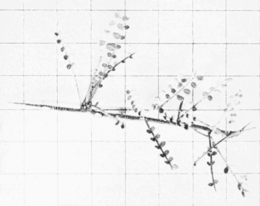(Zygophyllaceæ) of which the plant is a representative, are coated with appressed hairs and varnished with a resinous secretion. After the advent of a rain, or if watered, the plant quickly responds, the leaves becoming bright green and its delicate yellow flowers coming out in great numbers. The shrub is flat topped, Yellow-flowered Opuntia. and in large areas where few other so large specimens grow, the foliage of many plants lies in a uniform layer parallel to the ground. The hard twigs and branches make excellent fuel particularly for the camp cook's fire.
Yellow-flowered Opuntia. and in large areas where few other so large specimens grow, the foliage of many plants lies in a uniform layer parallel to the ground. The hard twigs and branches make excellent fuel particularly for the camp cook's fire.
Associated with the creosote bush, in numbers varying with the locality, are several species of cacti of the genus Opuntia, but of the type of Opuntia arborescens. and not possessed of the flattened branches of the common prickly pear. Of these, which are more dense tree-like in form, the one known locally as the cholla[1] attracts one's attention most quickly. Its smaller branches, clothed with numerous white spines, are curiously massed into formless bunches many of the smaller joints hanging down and sooner or later breaking off. Thus collect beneath the plant piles of dejecta membra, many dead, some dying. These broken off parts may serve to propagate the plant; when seed-pods are so cast off they more likely serve this end. In the agglomerations of branches just described birds cunningly build their nests; and these are hardly to be noticed but for the knowledge that they are  Twig of Palo verde. frequently found in such places. The few stout ungainly stems of these plants, and, as one may say, the weird disposition of the lesser branches, glistening in their coating of gray shining spines, produce a habit which, in the language of the advertisement, is peculiar to itself. When, as often happens, the cholla has the monopoly of the situation, the desert aspect becomes very pronounced. Two other species of this type are common, the so-called Opuntia spinosior, with pink flowers, and another (O. versicolor), with yellow ones. These, however, do not show
Twig of Palo verde. frequently found in such places. The few stout ungainly stems of these plants, and, as one may say, the weird disposition of the lesser branches, glistening in their coating of gray shining spines, produce a habit which, in the language of the advertisement, is peculiar to itself. When, as often happens, the cholla has the monopoly of the situation, the desert aspect becomes very pronounced. Two other species of this type are common, the so-called Opuntia spinosior, with pink flowers, and another (O. versicolor), with yellow ones. These, however, do not show
- ↑ Pronounced Cho-ya (Opuntia fulgida).
